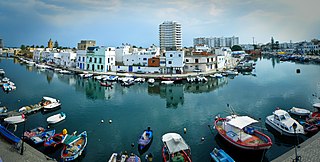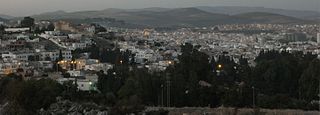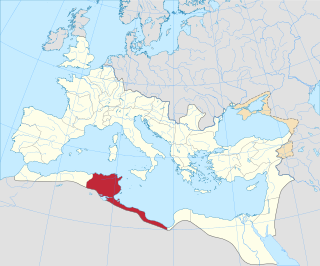
Tunis is the capital and largest city of Tunisia. The greater metropolitan area of Tunis, often referred to as "Grand Tunis", has about 2,700,000 inhabitants. As of 2020, it is the third-largest city in the Maghreb region and the eleventh-largest in the Arab world.

Bizerte or Bizerta the classical Hippo, is a city of Bizerte Governorate in Tunisia. It is the northernmost city in Africa, located 65 km (40mil) north of the capital Tunis. It is also known as the last town to remain under French control after the rest of the country won its independence from France. The city had 142,966 inhabitants in 2014.

Byzacena was a Late Roman province in the central part of Roman North Africa, which is now roughly Tunisia, split off from Africa Proconsularis.

Béja is a city in Tunisia. It is the capital of the Béja Governorate. It is located 105 kilometers (65 mi) from Tunis, between the Medjerdah River and the Mediterranean, against the foothills of the Khroumire, the town of Béja is situated on the sides of Djebel Acheb, facing the greening meadows, its white terraces and red roofs dominated by the imposing ruins of the old Roman fortress.
Sidi or Sayidi, also Sayyidi and Sayeedi, is an Arabic masculine title of respect. Sidi is used often to mean "saint" or "my master" in Maghrebi Arabic and Egyptian Arabic. Without the first person possessive object pronoun -ī (ي-), the word is used similarly in other dialects, in which case it would be the equivalent to modern popular usage of the English Mr. It is also used in dialects such as Eastern Arabic, as well as by Muslims of the Indian subcontinent in the Urdu language where, however, it does not have as much currency as Sayyid , Janab or Sahib.

The name Early African Church is given to the Christian communities inhabiting the region known politically as Roman Africa, and comprised geographically somewhat around the area of the Roman Diocese of Africa, namely: the Mediterranean littoral between Cyrenaica on the east and the river Ampsaga on the west; that part of it that faces the Atlantic Ocean being called Mauretania, in addition to Byzacena. Thus corresponding somewhat to contemporary Morocco, Algeria, Tunisia and Libya. The evangelization of Africa followed much the same lines as those traced by Roman civilization.

Hergla is a small cliff-top town in north-eastern Tunisia at the Gulf of Hammamet. White houses of Hergla with often blue window and door surroundings are built in the classic style characteristic for Tunisia. Sousse is about 24 km south-east of Hergla. There is a lagoon between Hergla and its neighbour town Chott Meryem in the south-east called Halk el menzel.
Sidi Bouzid, sometimes called Sidi Bou Zid or Sīdī Bū Zayd, is a city in Tunisia and is the capital of Sidi Bouzid Governorate in the centre of the country. Following the suicide of Mohamed Bouazizi in Sidi Bouzid, it was the site of the first clashes of the Tunisian Revolution and a catalyst for other protests in the region, often known as the Arab Spring.

Almost all Roman roads in Africa were built in the first two centuries AD. In 14 AD, Legio III Augusta completed a road from Tacape to Ammaedara: the first Roman road in Africa. In 42 AD, the kingdom of Mauretania was annexed by Rome. Emperor Claudius then restored and widened a Carthaginian trail and extended it west and east. This way the Romans created a continuous coastal highway stretching for 2,100 miles from the Atlantic to the Nile. In 137, Hadrian built the Via Hadriana in the eastern desert of Egypt. It ran from Antinoopolis to Berenice.
Bizerte-Sidi Ahmed Air Base is a Tunisian Air Force base located approximately 7 km west of Menzel Abderhaman, and 9 km west-southwest of Bizerte.

Ras Jebel, also known as Ras el-Djebel, is a town, commune, and archaeological site on Cap Sidi in the Bizerte Governorate of Tunisia. The name of the city refers to the summit or end of the mountain, thus evoking the end of the Atlas Mountains.

Sakiet Sidi Youssef is a town and commune in the Kef Governorate, Tunisia, near the border with Algeria. As of 2014, it had a population of 6,335.

Korbous is a town and commune in the Nabeul Governorate, Tunisia. As of 2004 it had a population of 3,551.

Bir El Hafey is a town and commune located at 34°55′48″N 9°12′00″E in the Sidi Bouzid Governorate, in Tunisia. As of 2004 it had a population of 6,405.
Sidi Bou Ali is a town and commune in the Sousse Governorate, Tunisia. As of 2004 it had a population of 9,011.
Sidi El Hani is a town and commune in the Sousse Governorate, Tunisia located at 35.67n, 10.30e. As of 2004 it had a population of 3,058. It gives its name to the largest lake of the governorate, a natural salt lake or salt pan (sabkha) in dry seasons, the Sebkhet de Sidi El Hani which is shared with between one and two other areas depending on precipitation and its maximum extent forms the official boundary with part of a third, Monastir Governorate. The town is 30 km south-west of the coast, its straightest connection being by Tunisian Railways, with a secondary connection by road, the P12 road which is a principal road to Kairouan from the A1 a few kilometres to the east. it is 19 km from Kairouan and 26 km from Raqqada.
Sidi Aïch is a small town, located at 35° 13′ 47″ N, 9° 07′ 46″ E in south-central Tunisia, it belongs to Gafsa Governorate and it is located in 29 km in the north of Gafsa.

Volitanus also known as Voli and Bolitana was a Roman era civitas (town) of Africa Proconsularis, a suffragan metropolis of Carthage in Roman North Africa.

Vallitanus or Vallis was an ancient Roman–Berber colonia in Carthage, Tunisia. The town is identified with ruins at Sidi Medien, where are located the remains of a Roman theatre, and a number of Roman inscriptions bearing witness to the town's name, and some local officials of the time can be found near the theatre.

Utimma was an ancient city in the Roman province of Africa Proconsularis during the Byzantine and Roman Empires. the exact location of Utimma is lost to history but it is believed to be between Sidi Medien and Henchir-Reoucha in Tunisia.















